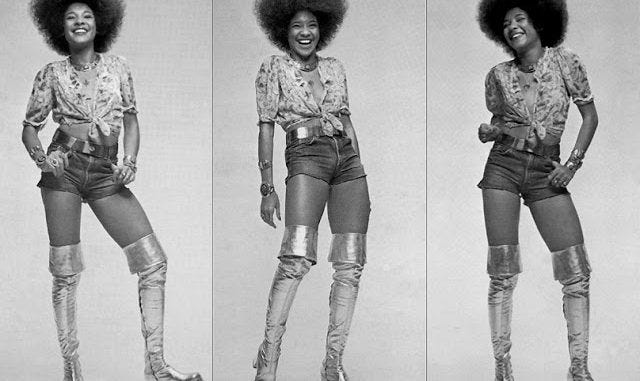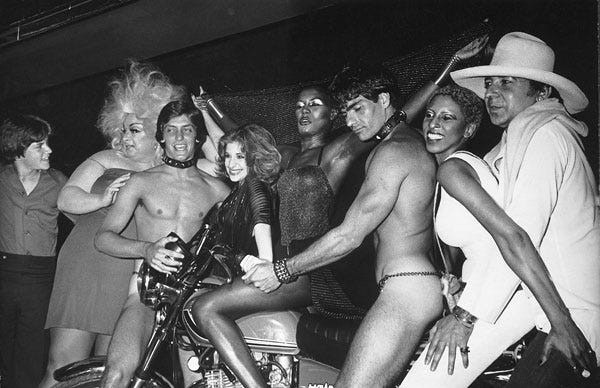After a week off that involved one of us possibly accidentally joining a cult, we are back. Thanks to this “retreat,” we now have all the answers about the universe; a new focus and meaning in life; a new … purpose. I guess what we’re saying is: friend, do you have a minute? Have you accepted NND into your life?
We know what you’re thinking: “what the fuck is NND?” Which we hear as you really saying “tell me more.” It’s okay. We know you’re skeptical. Such an incredibly powerful life-changing phenomenon simply cannot be. There is definitely no single thing on this scorched Earth of ours that will inspire you to order some $5 hot pants online, paint yourself silver, hang a disco ball in your kitchen and (7 to 10 weeks later, when your inferior-quality hot pants show up on your neighbor’s porch in a battered UPS package) Hustle around your house like you’re in the middle of a global pandemic. NO THING, SATAN.

Photo: WikiCommons.
But friends, gather round and listen closely, because we are here to tell you that eternal salvation and hot sticky nights are just a few stops away when you board the Soul Train, Destination: Norwegian (Nu)Disco (or as our brothers and sisters call it, NND).

Now, while the influence of 70s-era disco (we’ll call it 7D) is clear when it comes to NND, it might technically be more accurate to call it Norwegian Studio 54, which, during its very brief existence (it was only open for 33 months) was really a gateway of sorts. Some might even say a portal to another dimension, where multiple pop culture/music space/time continuums existed at once: disco, electronic, break beat and new wave — all blurred together in a glorious haze of coke, Quaaludes and glitter.

Photo: WikiCommons.
Like Studio 54, NND has a lot going on: 7D influence meets early 2000s electronic sensibilities meets the Norwegian love of jazz. Oh, and space. Lots and lots of space. In case you missed it, what we’re saying is that NND is spacey AF. NND is so spacey that if it was a monster, you would call it Kevin.
The space vibes may initially feel like a modern spin, but really there were always some spacey/fantasy elements to 7D, from Earth Wind and Fire’s subtle take in Fantasy to deep cuts like Ahsa Pulhli’s Space Talk. After all, we’re talking about that period of time nestled firmly between Barbarella and Xanadu. And do we even need to mention Meco’s “Star Wars and Other Galactic Funk?” Well, we just did. So, we guess we do.
Hence, it’s certainly not a stretch to picture Grace Jones and pals having a helluva time on the dance floor with some spacey NND as the back drop:
Hear us out: a remake of Saturday Night Fever.
The year is 2050. The setting is Oslo. John Travolta is (nu)dead. The cast is, well, basically the entire Skarsgard family. Yes, yes, we know they’re not Norwegian; but they are Norwegian-adjacent and basically the most beautiful family on the planet. Well, except for the one brother, because every family has *one* (we’re looking at you Daniel Baldwin). So … just go with it.
The lights in the theater dim. The screen lights up: cue copious establishing shots of (most likely post-apocalyptic) Oslo; then, a few opening credits, in an anachronistic font. Ever so subtly, the music starts to fade in. We pan over to our TBD Skarsgard (take your pick, but not the ugly one), who struts, all pre-Scientology-Travolta-like, down the street:
Unlike the original, you’ll notice this soundtrack is much less vocal-driven. For the most part, NND flips the scales a bit in terms of instrumental vs. vocals. 7D evolved in part from Motown and soul (just follow the Temptations from My Girl to Brick House to see what we mean), so vocals still figured prominently. Lots of songs about love and sex. Perfect backdrop for, well, lots of love and sex. Oh, the 70s. (Walk away, Daniel Baldwin.)
Anyway, maybe it’s because of the broader electronic music scene, or maybe it’s because by the early 2000s people didn’t really give a shit about love stories anymore, but NND is almost exclusively without vocals. All the better to give yourself over to the dance floor with, friend. Join us. (Of course, there were a bunch of instrumental 7D hits, too, so NND isn’t exactly reinventing the wheel in that sense, but still - no Bad Girls soap operas here.)
Another key difference between NND and 7D: the latter was slathered in musk oil and steeped in excess, with more than a hint of reckless abandon (sometimes bordering on frenzy, like in that climactic crescendo in The Trammps’ Disco Inferno). Perhaps channeling a Norwegian sensibility, or perhaps an indication of how different the world view and sexual landscape had become by the 2000s, NND shows a restraint that 7D did not. But it’s in that restraint that some of the best moments in the genre can be found. It’s still sexy. But not so musky. It’s more like disco essential oils. Apply as needed to whatever ails you. Save 10% when you order with automatic refills.
Can you dig it?
You’re not convinced. “Dude, it’s just house music,” you protest. We’re not going to necessarily fight you, unless you call us “dude” again, because this is very decidedly cross-over music. Hell, some of it borders on what people like to deride as “easy listening” (a fate that has also befallen lots of 7D tracks).
Take this track by Olav Brekke Mathisen, for example — which you could just as easily hear while double-fisting gin and tonics at a club as you could at, say, the waiting room for “Double Fisted,” the trendy new combination gynecologist/proctologist in downtown LA (don’t even fucking think about it, Ryan Murphy, we called it first):
Still, the disco influence here is unmistakable … bump the vocals down an octave, all of a sudden Barry White is telling you to spread your wings, baby.

Let us illustrate further by doing a quick compare and contrast. We’ll start with Herb Alpert’s Rise, one of the most well-known 7D instrumentals (also infamous for being the song played during *that scene* with Luke and Laura on General Hospital). We’re sure you know the other two, as well:
Now, listen to these three next tracks, which hey! what a coincidence! introduce you to who we think are the three lead horses in the NND race (based on our week of research): Todd Terje, Lindstrøm, and Prins Thomas. We’ll be talking about each of them a bit more throughout the week. You know, once we learn about them and stuff.
It’s not a one-to-one comparison, and it’s not meant to be. This ain’t your parents’ disco, and these aren’t remakes. Hell, we’d probably really actually hate them if they were. (We wonder: do people even remake disco tracks? It’s probably a pretty fruitless endeavor. If you know of good ones, tell us in the comments.)
We digress. Just listen. LISTEN. Leave the past behind you. Free yourself of personal belongings. Give yourself over to that higher (dance) power. Ask yourselves: WWNNDD? Then, and only then, will you know where salvation is to be found: in a white poly suit, under the disco ball, with a Harvey Wallbanger in hand. Right on, man. Right on.
And now, we’ve gotta bounce … It’s time for backwards skate.
Tasting Notes:
1. Fantasy/futuristic/spacey vibe
2. Primarily instrumental
3. 70s-era disco influences: disco clap, funk/soul rhythms
4. 2000s house music/DJ influences
(Post Script/Caveat: (Nu)Disco is not limited to Norway. We just happen to be focusing on the diverse group of Norwegian artists who are making it. Don’t be surprised if we visit different iterations in later weeks.)


